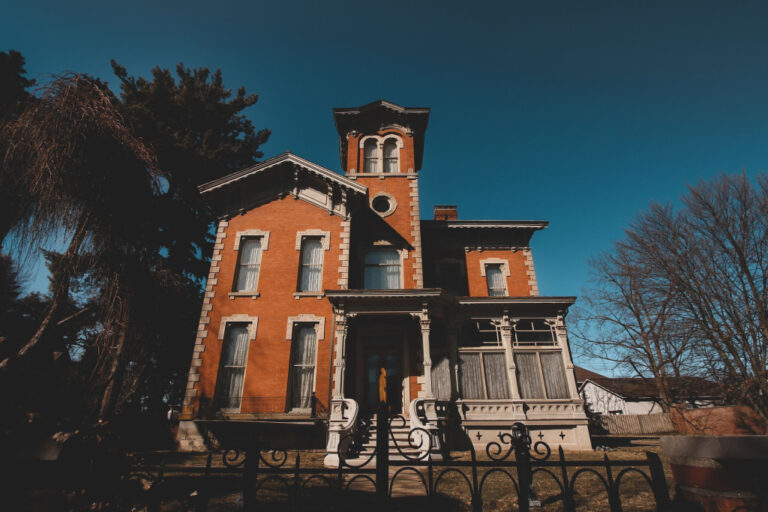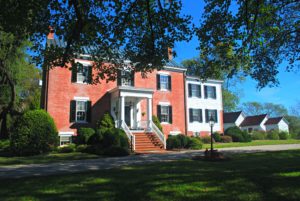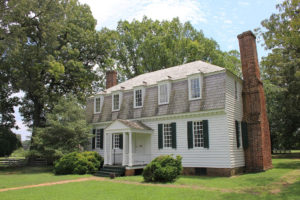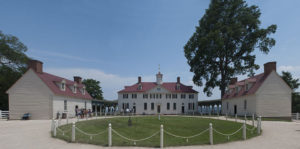Photo by Liz Weddon on Unsplash
Central Virginia is home to a wealth of historic architecture, with various styles and influences from the Colonial to Victorian eras.
From grand plantation estates to modest worker cottages, the state’s historic homes offer a glimpse into the past and a unique window into the lives of those who lived there. These homes have witnessed significant events throughout Virginia’s history and have played a critical role in shaping the cultural and social fabric of the state.
However, with time, these homes can become weathered and worn out and may require significant work to restore them to their former glory. Undertaking a historic home remodel is a meaningful way to preserve the unique character of Central Virginia’s historic homes and ensure that they continue to be treasured for years to come.
How to Make Your Central Virginia Historic Home Look Like New
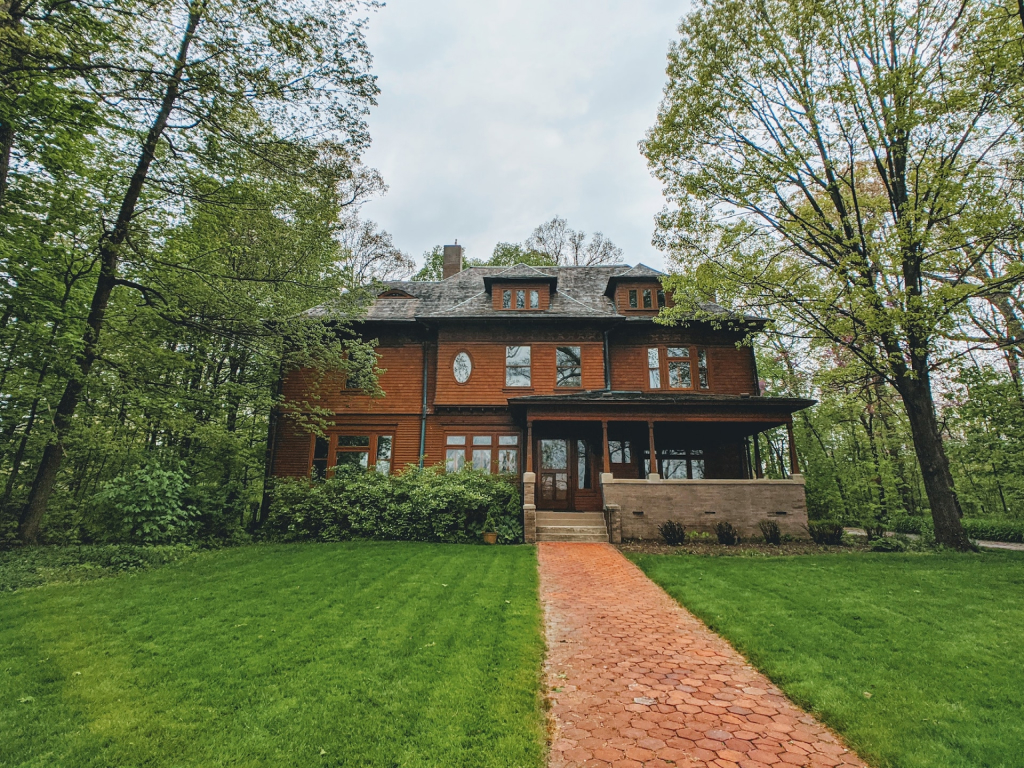
Photo by Adam Bouse on Unsplash
Owning a historic home comes with its own challenges, especially when maintaining the home’s original charm while keeping it up-to-date. If you’re working on renovating or restoring a historic home or even just thinking about embarking on your renovation project, here are the steps you might want to consider.
Assess Property Condition
The first thing to do when doing historic renovations in Central Virginia is to assess the property’s overall condition. This will involve inspecting the house’s exterior for any signs of damage, such as cracks or rotting wood. If any damage is found, it is essential to address it immediately to prevent further deterioration.
One way to do this is to hire a professional contractor with experience working with historic homes. They will be able to identify and repair any damage while maintaining the integrity of the original materials.
Home Interior Update and Refurbishment
Updating the home’s interior is another way to do when undertaking a historic home remodel to give it a fresh look while maintaining its historic charm. You can replace outdated fixtures or appliances with modern versions that mimic the original style.
For example, if the home has an old-fashioned clawfoot tub, replacing it with a newer version with the same style can make a big difference. Replacing old light fixtures with modern fixtures that resemble the originals can also give the home a more updated look.
Pay Attention to the Details
Paying attention to the details when updating a historic home is also essential, like focusing on the small things, such as the hardware on the doors and cabinets.
Updating these details can give the house a more polished look while preserving its historic character. It is also vital to ensure that any new additions, such as furniture or artwork, complement the home’s overall aesthetic.
Improve Property Landscaping
Another way to renovate or remodel your historic home is to focus on landscaping. A well-manicured lawn and carefully selected plants can enhance the home’s curb appeal and make it look more inviting.
It is also essential to ensure that any trees or bushes are not encroaching on the home’s foundation or causing damage to the roof. A professional landscaper can help you design a plan to complement the home’s architecture and highlight its historic features.
Preserving Original Features While Incorporating Modern Design Elements
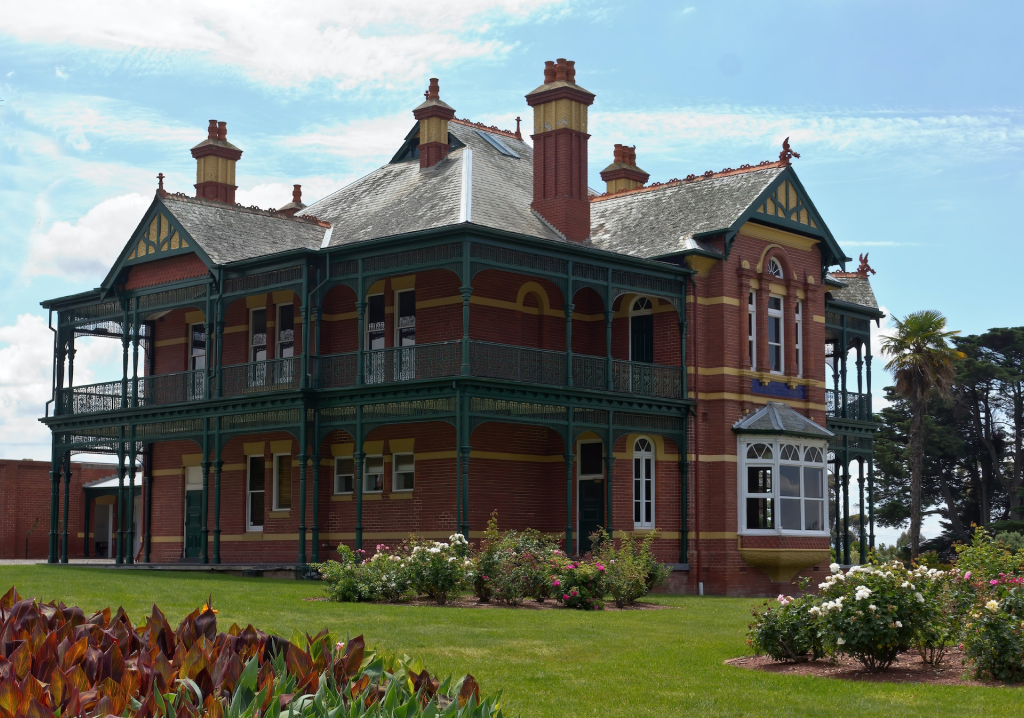
Photo by John Torcasio on Unsplash
Central Virginia’s historic homes are prized for their historical significance and architectural beauty, making them an integral part of Virginia’s cultural heritage.
However, today, people also demand modern amenities, conveniences, and a home or building that can accommodate these needs. Therefore, it is crucial to strike a balance between preserving the original features that make a building unique and incorporating modern design elements when renovating that meet the needs of contemporary living.
Keeping the original features of a historic home while incorporating modern design elements can be challenging, but it is possible!
One way to preserve original features while incorporating modern design elements is by choosing materials and finishes that complement the original structure. For instance, when doing a historic home bathroom remodel, it is essential to remember the house’s unique character.
When choosing the right flooring for a bathroom remodel in a historic home, it’s essential to consider both the practical and aesthetic aspects of the flooring. If the home is a Victorian-era house with ornate moldings and fixtures, consider incorporating vintage-inspired clawfoot tubs and brass fixtures.
Similarly, if you are undertaking a historic home kitchen remodel, modern fixtures and appliances can be installed in a kitchen while preserving the original cabinetry, flooring, or ceiling details that make the space unique.
Another example is when a historic home has a classic brick exterior. In that case, modern design elements can be incorporated using sleek metal accents or large, floor-to-ceiling windows that add a contemporary touch.
Updating The Exterior Of Your Historic Home For Enhanced Curb Appeal
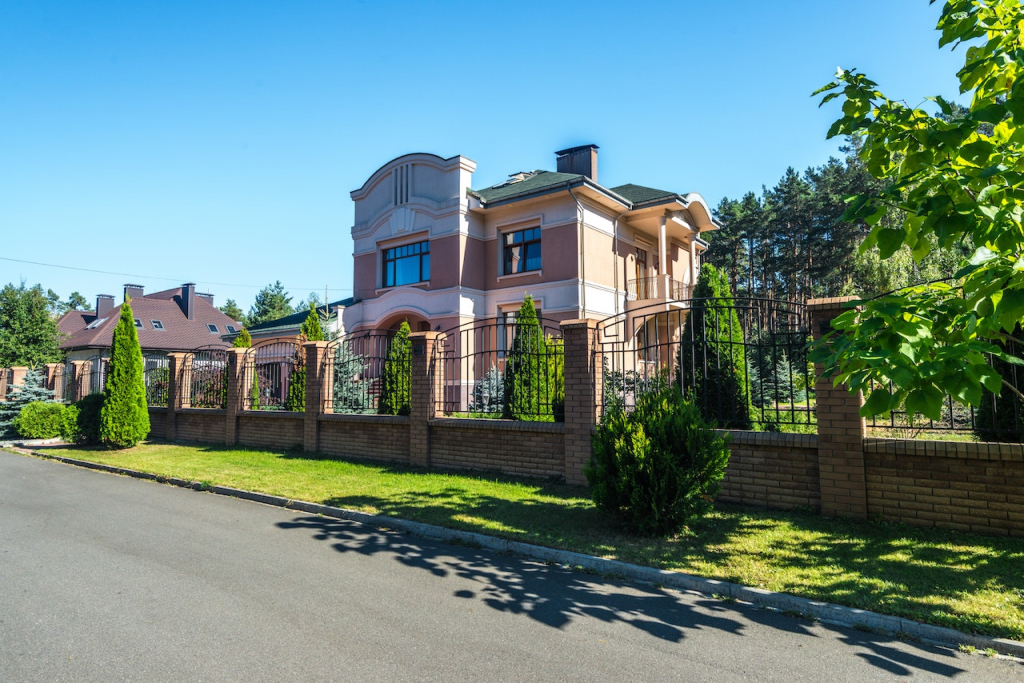
Photo by Max Rahubovskiy
Updating the exterior of a historic home can be a challenging task, but it can also be a great way to enhance its curb appeal. Improving your home’s curb appeal can increase its value and make it more attractive to potential buyers or visitors.
However, when dealing with historic renovations in Central Virginia or planning to remodel a historical home, preserving its character and unique features is essential while making necessary improvements.
When undertaking a historic home remodel or renovation, you should first assess its current condition. Inspect the roof, siding, windows, doors, and trim for any damage or wear and tear. To prevent potential damage to your home’s structure, prioritize repairs and maintenance tasks like repainting, repairing leaks, and replacing broken windows.
Next, consider enhancing your home’s curb appeal by adding decorative elements that complement its architectural style. You could repaint the exterior with historically accurate colors or add a porch or balcony that matches the home’s original design. If your budget allows, upgrading your home’s landscape can significantly impact its curb appeal.
Consider planting native plants or flowers that thrive in Virginia’s climate, adding walkways or garden beds, or installing outdoor lighting that highlights your home’s unique features.
When updating the exterior of your historic home, it’s essential to work with professional historic renovation contractors who understand the unique challenges and requirements of preserving a historic home’s integrity. Consult also with a local historic preservationist or architectural historian to ensure your renovations comply with local zoning laws and historic preservation guidelines.
Common Mistakes To Avoid When Renovating Or Updating A Historic Home In Central Virginia
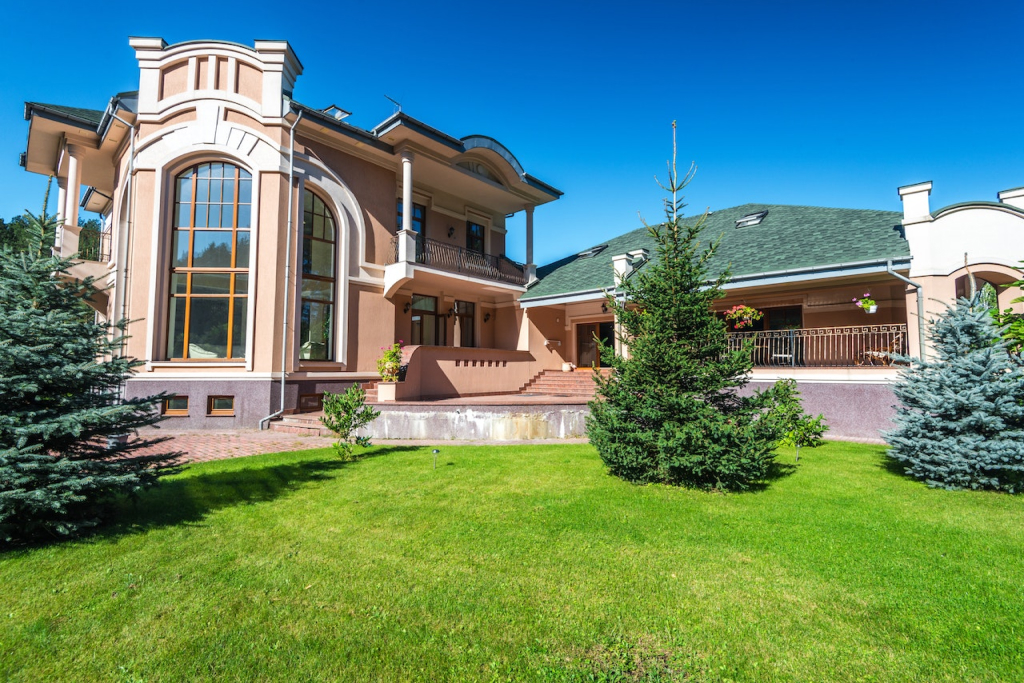
Photo by Max Rahubovskiy
Renovating or remodeling a historic home in Central Virginia can be daunting, especially if you are unfamiliar with the unique characteristics and requirements of these homes.
While preserving the character and charm of these homes is important, there are common mistakes that homeowners often make when undertaking a historic home remodel or renovation that can detract from the overall beauty and value of the property.
Failure to Obtain Permits and Licenses
The first and most common mistake is failing to obtain the necessary permits and approvals from local authorities.
Historic homes in Central Virginia are often subject to strict guidelines and regulations, and the local historic preservation commission must approve any modifications. Obtaining the proper permits and approvals is crucial to avoid fines, delays, and legal action.
Failure to Hire a Professional Contractor
Failing to hire a professional contractor with experience with historic homes is another common mistake. Historic homes often require specialized knowledge and techniques and hiring historic renovation contractors who understand the unique challenges of renovating these properties is crucial.
A professional contractor can help you navigate the permitting process, suggest appropriate materials and finishes, and ensure the renovation is done correctly.
Over Renovating
Another mistake to avoid is over-renovating the home. While it may be tempting to update every aspect of the house to modern standards, over-renovating can detract from the historic character and charm of the property.
It’s essential to strike a balance between modern convenience and historic preservation.
Sacrificing Quality
Finally, it’s essential to avoid sacrificing quality for cost. While cutting corners to save money may be tempting, using inferior materials or hiring inexperienced workers can result in costly repairs and lower property value in the long run.
Investing in quality materials and skilled labor is essential to ensure that the renovation is done correctly and adds value to the property.
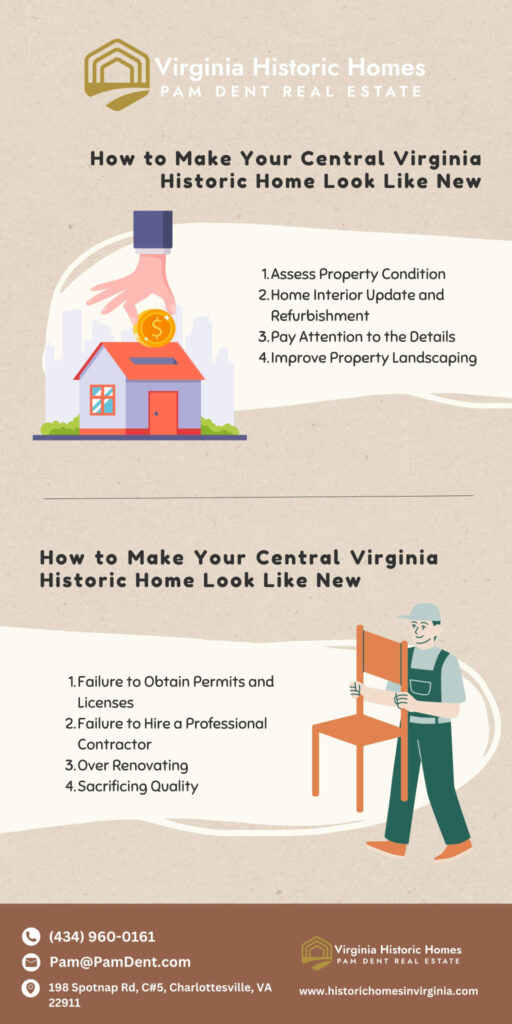
Wrap Up
This article discusses how to make a historic home in Virginia look new. These homes, ranging from grand estates to worker cottages, provided insight into Virginia’s past and significantly shaped the state’s culture and social fabric.
Undertaking a historic home remodel can preserve the unique character of these homes while ensuring that they are treasured for years to come.
Assessing the property’s overall condition is the first step you can do when renovating or remodeling your Central Virginia historic home and repairing any damage is essential.
Updating the home’s interior, paying attention to details like hardware, and focusing on landscaping can give the house a more polished look while preserving its historic character.
You can choose materials and finishes that complement the original structure to preserve the original features while incorporating modern design elements.
Furthermore, when enhancing the home’s curb appeal through repairs, adding decorative elements, upgrading the landscape, and using historically accurate colors are vital steps to updating the exterior of a historic home.
Lastly, working with professional historic renovation contractors who understand the unique challenges and requirements of preserving a historical home’s integrity is essential.
If you’re curious and would like to learn more about how to make your Central Virginia historic home look new, please don’t hesitate to contact us at (434) 960-0161. I am inclined and will be happy to assist you and offer any information you may require.
Additionally, if you want to stay informed about Central Virginia, we suggest that you follow us on our social media channels:
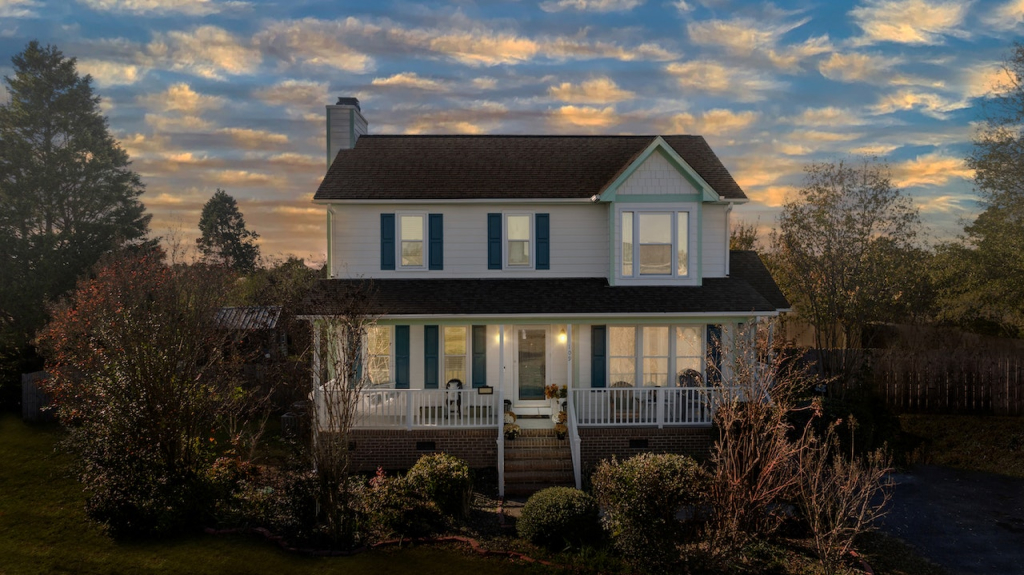
Photo by Curtis Adams
Frequently Asked Questions
How to remodel a historic home?
Renovating a historic home requires thorough research about the home’s history, retaining original architectural features, using historically accurate materials, and avoiding changes that could damage the home’s integrity.
You can visit the handbook for Virginia’s historic homeowners for more information.
What are some cost-effective ways to update a historic home in Central Virginia while preserving its original character?
To update a historic home in Central Virginia while preserving its original character, consider simple and cost-effective updates such as fresh paint, refinishing hardwood floors, and updating lighting fixtures.
Add modern amenities while retaining historic charm by installing energy-efficient windows and appliances that blend seamlessly with the home’s architecture. Consider repurposing salvaged materials, such as doors or hardware, to maintain the original character of the house while updating it.
How can you incorporate modern design elements into a historic home without compromising its authenticity?
To incorporate contemporary design elements into a historic home while preserving its authenticity, try blending old and new materials, creating an open floor plan, emphasizing natural light, and using contemporary furnishings that complement the home’s original architecture.
What should you consider when choosing paint colors and finishes for a historic home in Central Virginia?
When selecting paint colors and finishes for a historic home in Central Virginia, consider the home’s architectural style, historical accuracy, and local regulations. Opt for classic colors and matte finishes preserving the home’s authenticity and charm.
How can you enhance the curb appeal of a historic home in Central Virginia without detracting from its historic charm?
To enhance the curb appeal of a historic home in Central Virginia without detracting from its magic, focus on maintaining its original features and architectural style while adding tasteful landscaping and a fresh coat of paint in historically accurate colors.
What are some common mistakes to avoid when renovating or updating a historic home in Central Virginia?
When renovating a historic home in Central Virginia, avoid the mistake of disregarding its original character, neglecting necessary repairs, over-modernizing, or making changes without obtaining proper permits. Work with professionals experienced in historic preservation to ensure a successful renovation.
